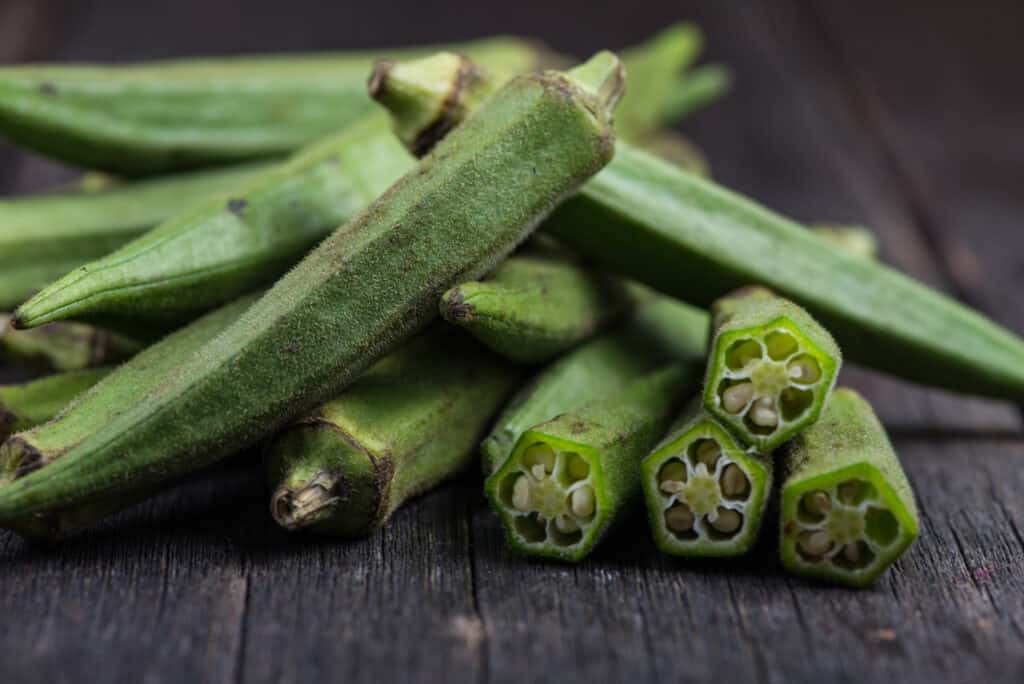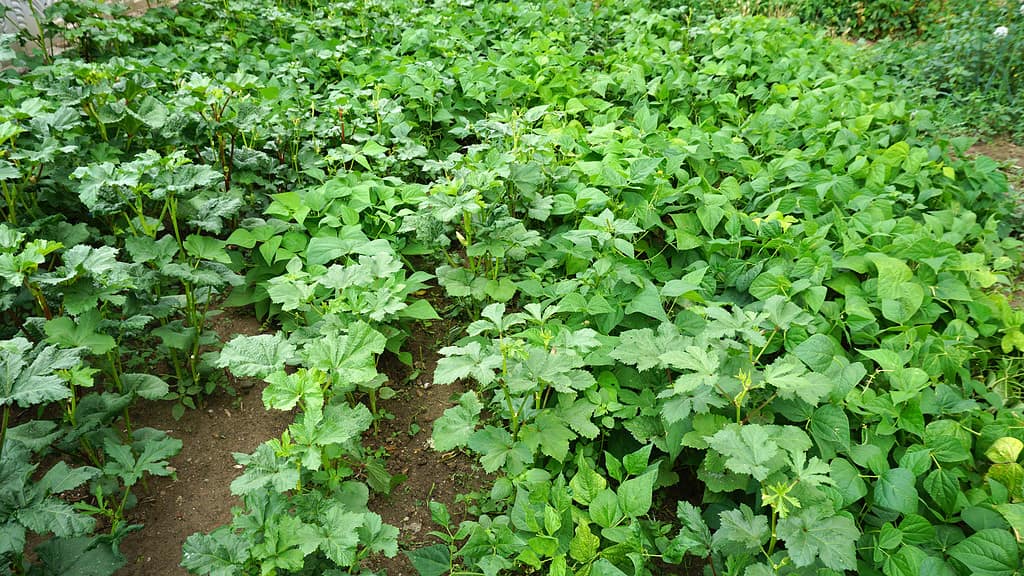Okra is a plant that flourishes in hot climates but can be grown in cooler climates, too. It’s simple to cultivate and use and has attractive flowers that can add to the garden’s beauty. Here’s all you need to know about planting, tending, and collecting Okra.
About Okra

Okra is believed to have originated in either
Africa
or Asia.
©marcin jucha/Shutterstock.com
Okra is a warm-weather crop that has been slowly but steadily making its way into northern states and gaining in popularity among gardeners and cooks all over the United States.
Besides providing tasty vegetables and beautiful flowers, Okra also provides a great deal of nutrition with its high levels of vitamin A and low-calorie count. Okra even looks like one of its relatives: the hibiscus! It belongs to the same family as this flower, which explains why they have similar features when you look at them closely. With so many advantages, it’s no wonder more people are growing Okra in their gardens!
The okra plant (Hibiscus esculentus) is a tall stalk-like plant with large leaves and yellow flowers. The immature seed pods are the edible part of the okra plant, sometimes referred to as lady’s fingers. Okra is the single member of the mallow family that is consumed in this manner, which also includes relatives such as cotton and durian.
Okra is believed to have originated in either Africa or Asia. There is currently a surge in the popularity of Okra around the world, particularly in Africa, the Middle East, and the United States. This hearty plant is now being seen at farmer’s markets across America as its health benefits are being discovered.
Where to Plant
Okra is a warm-weather crop that needs full sun and hot temperatures throughout the day in order to grow. In particular, evening temperatures should be at least 60°F or higher for optimal growth.
The soil must also be fertile and well-drained with a neutral pH of 6.5 to 7.0. Before planting, mix compost or manure into the soil, as Okra is a heavy feeder and will require plenty of nutrients from the soil to thrive.
When to Plant

In most cases, you should sow Okra directly into the garden four weeks before the last spring frost date.
©Pk_camera/Shutterstock.com
To ensure the best possible growth of your okra plants, plant them at the right time. In most cases, you should sow Okra directly into the garden four weeks before the last spring frost date.
To protect against any cold weather that may come after planting, cover with a cold frame or gardening hoop. This will help keep temperatures steady and provide enough height for your plants to grow without being restricted. If you don’t have any materials to use for cold protection, wait until the soil is 65° or more before planting seeds outdoors.
If your summers are shorter in length due to more northern climates, start okra seeds indoors in pots under full light 3-4 weeks before your last frost date. Make sure that these indoor seedlings have been hardened off by gradually introducing them outdoors over a period of 7-10 days before transplanting outside, as this will aid their success rate when grown outdoors in colder climates.
How to Plant
Once you have your okra seeds, prepare them for planting. Okra’s pea-sized seeds have a hard shell, so soak them in warm water for a few hours prior to sowing. This will help speed up germination and ensure the best possible outcome.
When you are ready to plant the Okra, place each seed about 1 inch deep into the soil. If you are planting okra transplants instead of seeds, be sure they have enough room by spacing them out 12 inches apart from one another. As these plants grow tall and sturdy, give yourself plenty of space between rows by keeping at least a three-foot distance between each row as well.
How to Grow

As these plants grow tall and sturdy, give yourself plenty of space between rows by keeping at least a three-foot distance between each row as well.
©hanif66/Shutterstock.com
Weeds can choke out okra plants, so it is important to eliminate them early on in the growing process. To prevent further weed growth, provide a deep (8-inch) layer of mulch around your okra plants. This helps keep weeds from sprouting and taking over your garden space.
Additionally, since Okra is a hungry plant, provide a balanced fertilizer or compost once per month throughout the season. Be careful not to apply too much nitrogen, as this will discourage flowering and encourage leafy growth instead – something you don’t want!
When the seedlings are about 3 inches tall, thin the plants and space them at least 12 inches apart. This will give them enough room to grow without competing for resources such as water and nutrients in the soil. Keep your okra plants well-watered throughout the summer to ensure healthy growth. An ideal amount of water would be one inch per week. However, if you live in a hot region with low precipitation levels, you may need more water than this. High heat can slow down the growth of Okra, so make sure that your plants are getting enough hydration during these warmer months.
In warm areas of the country, some growers cut the plants back to around 2 feet in height when growth slows during the summer months. The plants will usually regrow and produce another crop of Okra later on in the season. In cooler northern climates, cut off the top of the okra plant after it is five feet tall for more lateral branches. When pruning okra plants, take precautions. Okra has hairy leaves and spines on the pods, which may irritate the skin without wearing gloves or long sleeves. This issue does not occur when eating the Okra, however.
When to Harvest
It is time to harvest your Okra when the pods are young; only one or two days old is best. They should be no more than 4 inches long. These pods will appear about two months after the seeds were planted. This is the optimal time for harvesting your Okra, as it is at its softest texture and most digestible at this stage. If you wait too long to harvest, the Okra can become tough or woody in texture, which makes it more difficult (and sometimes unpleasant) to consume. Additionally, if left on the plant for too long, some of the nutrients that make Okra so nutritious may decrease significantly. It’s best practice to regularly check your plants from around two months onward so that you don’t miss out on any delicious harvest!
How to Harvest

Make sure to harvest often in order for more flowers to form on your plants. It only takes a few days for these flowers to turn into fruit!
©Lahore Qalandars7/Shutterstock.com
When harvesting Okra, cut the stem just above the cap with a sharp knife. If it is too difficult to cut through, then the pod has most likely aged and should be discarded.
Make sure to harvest often in order for more flowers to form on your plants. It only takes a few days for these flowers to turn into fruit!
If you plan to save seeds, let the pods mature on the plant and harvest the seeds for the next season. In case of an impending freeze that could damage pods, you can take the plant inside and hang it up somewhere dry with a paper bag over it so if any of the pods open, their seeds won’t be lost either.
How to Store

Canned Okra lasts for 12 months.
©BearFotos/Shutterstock.com
There are several options when storing Okra. You can put uncut and raw pods into freezer bags and keep them in the freezer for up to eight months. Alternatively, you can blanch Okra before freezing it to extend its shelf life even longer.
Canning is another option if you want access to fresh-tasting Okra throughout the winter. When canning, ensure your jars are properly sealed and stored in a cool, dark place away from direct sunlight or heat sources. Canned Okra lasts for 12 months.
Companion Plants
Companion plants serve several different purposes. They can repel insects, attract beneficial bugs, add nutrients to the soil, or provide ground cover. Other companion plants provide shade, act as a supporting stalk, or serve as a planting marker. Ideal companion plants for Okra are calendula, sage, geranium, thyme, dill, tansy, chives, oregano, chamomile, coriander, mint, broccoli, Brussels sprouts, kale, sunflowers, and nasturtiums.
Calendula. Calendula can be helpful in keeping away Japanese beetles, aphids, and vine borers. Additionally, this flowery plant is attractive to bees and other pollinators.
Aromatic flowers and herbs. Okra plants can be encouraged to grow stronger with the addition of certain companion plants, such as sage, geranium, thyme, dill, tansy, and chives. Oregano, chamomile, coriander, and mint are also great companions. These plants serve to keep away moths and mites while also attracting pollinators.
Brassica Family. Members of the brassica family, like broccoli, Brussels sprouts, and kale, add nutrients to the soil. These added nutrients help your Okra thrive.
Sunflowers. Sunflowers can provide support, like a stake, for your tall okra plants. They also attract birds and pollinators that eat insects and pollinate plants.
Nasturtiums. Planting Nasturtiums near your Okra will bring in helpful insects which can help protect the Okra from pests such as beetles and aphids.
Summary of How to Grow Okra
| Growing Okra | Okra Recommendations |
|---|---|
| Sun | Full sun. Six or more hours of direct sunlight |
| Soil | Nutrient-rich soil that is well draining and has a pH of 6.5 to 7.0 |
| When to Plant | Four weeks before the last frost date with row covers. Soil temperature of 65°F without row covers. |
| Planting Measurements | Plant seeds one inch deep and 12 inches apart. Space rows three feet apart. |
| When to Harvest | Harvest in 60 days when pods are less than four inches long. |
| Storage | Whole pods can be frozen for eight months or canned for 12 months. |
| Companion Plants | Calendula, sage, geranium, thyme, dill, tansy, chives, oregano, chamomile, coriander, mint, broccoli, Brussels sprouts, kale, sunflowers, and nasturtiums. |
5 Types of Okra
Clemson Spineless – This variety produces four-foot tall plants requiring little or no pruning. The pods are between six and nine inches long and very tasty.
Blondy – This is a cultivar that was bred to be spineless, so it is easier to handle with bare hands. It is a dwarf variety that only reaches three feet tall. It is quick to maturity and a great choice for gardeners in the northern USA. The pods are three inches long.
Cajun Jewel – This cultivar is another dwarf variety that stays under four feet tall and rarely needs pruning. The pods are sweet and only one inch in diameter and eight inches long.
Louisiana Green Velvet – This is a spineless cultivar that you can grab ahold of without gloves. It is a vigorous grower and needs plenty of space. It will reach over six feet tall in no time at all.
Burgundy – This cultivar has plum-colored stems and fruits! The purple-red color looks amazing next to the bright green leaves. The pods reach eight inches but should be harvested before they get that long. The plant grows five feet tall and makes for a colorful garden statement.
The photo featured at the top of this post is © Lahore Qalandars7/Shutterstock.com
Thank you for reading! Have some feedback for us? Contact the AZ Animals editorial team.






